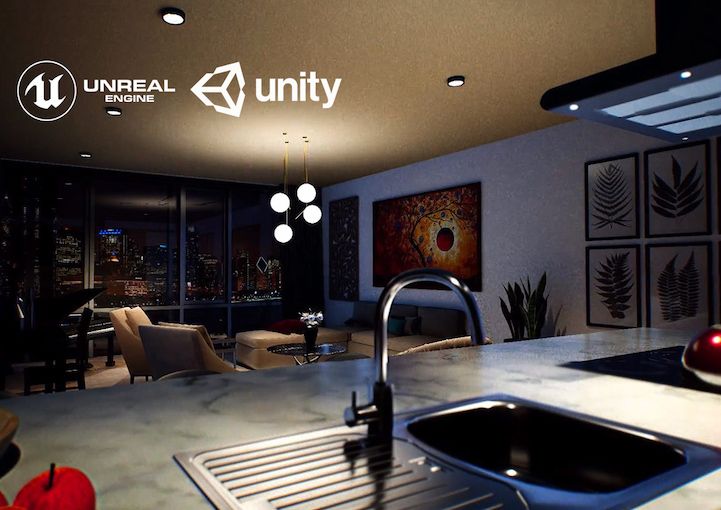3 Tips When Using Game Engines for Photorealistic AEC and Virtual Home Projects

Game engines are useful beyond the gaming world, and the AEC / home building industry is reaping the lion’s share of the benefits. Architectural visualization firms can rapidly render 3D show homes with the right lighting, shading, and finishes required for a realistic representation.
The two leaders in this industry are Unity and Unreal Engine. Over the past few years, these game engine companies have enhanced their offerings to provide more value for enterprises, particularly in the AEC world.
Consolidate real-time 3D workflows into one tool
Unreal and Unity have introduced features that allow users to communicate AEC-specific information, like business information modelling (BIM) data, within their interactive 3D renderings. In addition, 3D content creators can work with CAD models from multiple tools like Rhino or AutoCAD in one place and access powerful rendering tools to bring their models to life.
ICYMI: 4 trends steering the future of collaboration through 3D visualization
In addition, game engines bring visual, audio, and physics tools all into one system, eliminating the need for developers to recreate functions that have already been programmed in the gaming world.
Easy import of data using enterprise tools designed by game engines
Unreal Engine’s Datasmith service allows non-game creators to easily import and prep BIM and CAD data. Rather than deconstructing and reconstructing elements for transfer into the game engine, Datasmith makes it easier for enterprise users to transfer their files.
Originally, Unreal planned to charge users $49 a month as part of a subscription once Datasmith came out of free beta. The company recently announced it would offer the service for free as part of Unreal Engine.
Meanwhile, Unity has partnered with PiXYZ to cut down on the amount of time 3D content developers spent preparing data for import. According to Tim McDonough, head of industrial at Unity, “Getting CAD data into Unity typically took about 70 percent of the time necessary for getting the data into the game engine”. Data is converted from popular formats like SOLIDWORKS, FBX, and others into optimized meshes.
Easy access to PBR-ready materials
Substance is a 3D texturing suite by Allegorithmic that gives users access to a rich library of PBR-ready materials. Instead of creating common design features from scratch, AEC firms can choose from libraries with high-quality assets. Unreal Studio partnered with Allegorithmic to provide enterprise users with over 100 substances for architecture materials.
HOK, a global architectural firm, uses Unreal Engine to quickly and easily create architectural visualizations for its commercial projects. One of the key goals of HOK is to create spaces that are accommodating and useful to the people who use them. HOK’s projects range from high-end residential towers to airports and hospitals.
Related Read: Why ray tracing isn’t just for video games (and which industries benefit most)
Within their design pipeline, they use a number of tools including SketchUp, Revit, and Rhino, but they are all used in isolation from each other. With Unreal, they’re able to bring these tools together by importing CAD data from these different sources to create real-time 3D scenes.
Want to learn more about game engines in the AEC industry and how to distribute your 3D applications via scalable cloud streaming? Download our latest white paper, Interactive 3D Streaming in real-estate: How Virtual Show Homes Help Buyers Play House to learn more.


